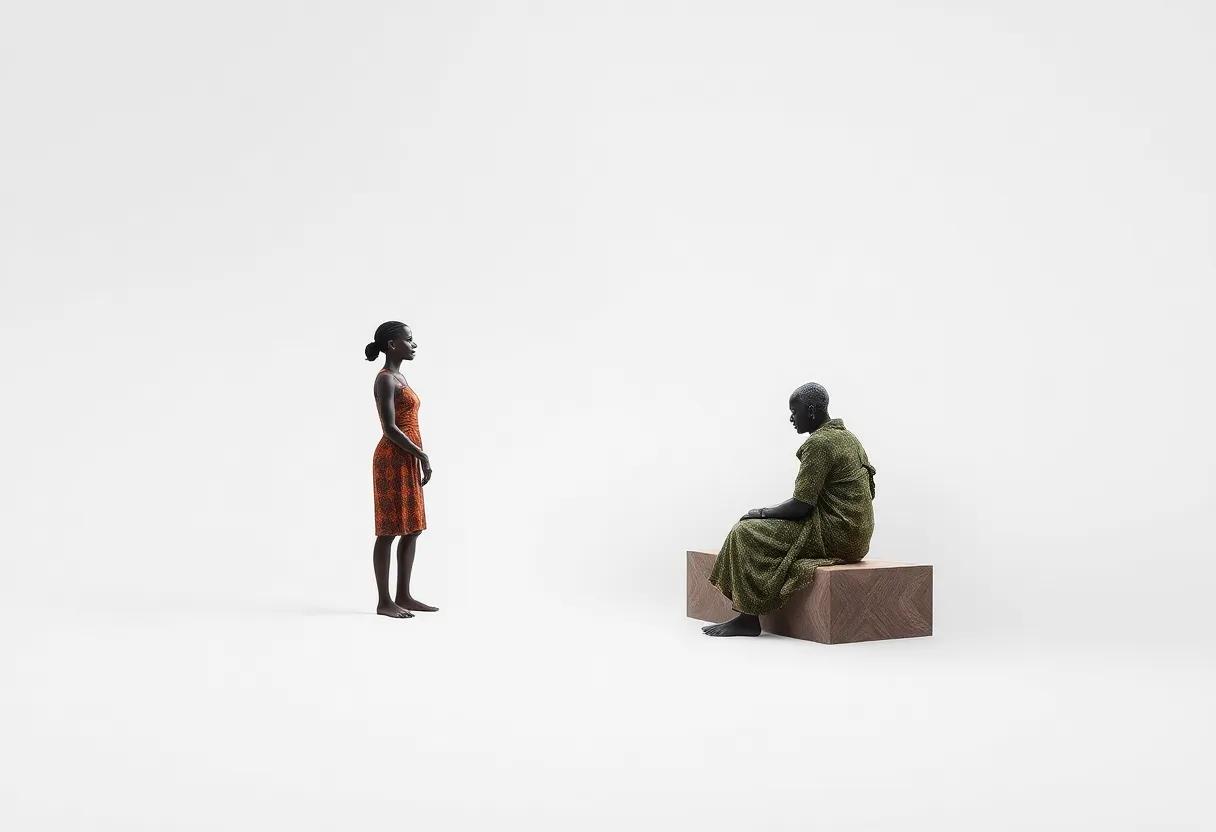In a world marked by division and turmoil, the power of hope emerges as a resilient thread woven into the fabric of human experience. In “Exploring Hope Amidst Despair,” we turn our gaze upon Alan Paton’s timeless masterpiece, “Cry, the Beloved Country.” this novel, set against the backdrop of 1940s South Africa, confronts the stark realities of racial injustice and social upheaval while simultaneously illuminating the enduring spirit of compassion and kinship. Through the tales of its deeply human characters, Paton invites readers to grapple with the complexities of despair while nurturing the seeds of hope. In this review, we delve into the ways in which “Cry, the Beloved Country” not only captures the struggles of its time but also serves as a poignant reminder that even in the darkest moments, the flicker of hope can illuminate the path toward healing and reconciliation. Join us as we explore the depths of despair and the heights of hope embodied in this classic literary work.
A Journey Through Pain and redemption in Cry, the Beloved Country

Alan Paton’s Cry, the Beloved Country is a profound narrative that traverses the landscape of South Africa, illuminating the heart-wrenching struggles of its people against the backdrop of racial injustice and societal breakdown. The journey of the protagonist, Stephen Kumalo, unfolds as he ventures from his rural home in Ndotsheni to the bustling streets of Johannesburg, where the hopes and dreams of many collide with reality. Through Stephen’s eyes, readers witness the disintegration of families and the erosion of moral values, all of which serve to highlight the broader themes of despair and loss. The stark contrast between the vibrant beauty of the south African landscape and the grim circumstances faced by its inhabitants invites reflection on the roles of faith and resilience in the face of adversity.
Amidst the overwhelming sorrow, Paton masterfully weaves a narrative of redemption that emerges through acts of kindness and the possibility of reconciliation. The relationships Stephen forms – with his son Absalom, who becomes entangled in crime, and with the compassionate Misses Msimangu – illustrate a deep-seated belief in humanity’s capacity for change. The novel emphasizes the importance of understanding and forgiveness as essential steps towards healing. As characters confront their own failings and seek forgiveness, the story transforms despair into hope, encouraging readers to envision a future where unity prevails over division. This quest for redemption not only reflects the personal journeys of the characters but also resonates with the broader implications for a society yearning for healing and justice.
The Landscape of South Africa: An Exploration of Physical and Emotional Terrain

The vastness of South africa’s landscape mirrors the complexities of its soul—an intricate tapestry woven with threads of beauty and suffering. From the majestic peaks of the Drakensberg mountains to the sprawling savannahs of the veldt, the physical terrain serves as both a backdrop and a character in the narrative of human struggle and resilience. The striking contrasts found throughout the country, such as the fertile valleys juxtaposed against parched deserts, evoke a sense of deep emotional resonance. Within the pages of *Cry,the Beloved Country*,the persistence of the land reflects the enduring spirit of its people,encapsulating the duality of hope and despair in each vivid description.
The emotional terrain is similarly layered and nuanced. Characters navigate the rugged paths of grief and forgiveness, embodying the struggles against injustice and the desire for connection. As they traverse the physical landscape, they confront not just the societal divisions birthed from apartheid, but also their internal conflicts. A table illustrating the parallel struggles is depicted below:
| Theme | Physical Landscape | Emotional Resonance |
|---|---|---|
| Isolation | Desolate plains | Loneliness and despair |
| Unity | Rivers meeting | Hope and reconciliation |
| Conflict | Mountain pass | Struggle and tension |
Characters as Mirrors: The Complexities of Humanity and Suffering
In Alan Paton’s poignant narrative, the characters serve as profound reflections of humanity, their struggles and triumphs encapsulating the essence of suffering in a divided society. Through the journeys of Stephen Kumalo and James Jarvis, the reader is confronted with the stark realities of grief, loss, and hope. Both men,though worlds apart in their experiences,mirror each other’s anguish as they grapple with the consequences of systemic injustice and personal tragedy. Their interactions expose the vulnerabilities that bind them, offering a layered understanding of redemption and the potential for compassion in the face of overwhelming despair. Paton invites readers to contemplate how suffering can lead to greater empathy and understanding, revealing our shared humanity in the darkest of times.
The intricacies of these characters extend beyond mere representation; they embody the broader social issues surrounding apartheid South Africa. The plight of Kumalo’s family highlights the disintegration of community and familial bonds, a theme echoed through the lives of those they encounter along the way. Conversely, Jarvis’ change from isolation to involvement illustrates the powerful impact of leading with one’s heart. In witnessing their development, readers are compelled to reflect on their own responses to suffering within their communities.The narrative artfully intertwines personal and political struggles, reminding us that each character’s journey impacts not only their destiny but also the fabric of society itself.
| Character | Role | Symbolism |
|---|---|---|
| Stephen Kumalo | Clergyman | Hope and Redemption |
| James Jarvis | Landowner | Understanding and Change |
| Absalom Kumalo | Kumalo’s son | Consequences of apartheid |
Hope as a Beacon: Resilience in a tapestry of Despair
In the face of overwhelming adversity, where despair frequently enough seems to cast a long and relentless shadow, the narrative of hope intertwines itself as a vital thread within the fabric of human experience.In Cry, the Beloved Country, Alan Paton masterfully illustrates how resilience emerges from the depths of sorrow. The trials faced by the characters not only encapsulate the stark realities of apartheid but also illuminate the transformative power of hope that propels individuals to strive for a better tomorrow. Through their struggles,we witness the profound truth that even in the bleakest moments,a flicker of optimism can ignite the flame of resilience,inspiring acts of courage that ripple through their communities.
This tapestry of despair is intricately woven with stories of personal sacrifice, unwavering love, and fierce determination, characters like Stephen Kumalo and James Jarvis embody the threads of connection that bind humanity together. As they navigate their tragic realities, their journeys reflect the essential belief that one can rise above chaos and loss. By embracing vulnerability and striving toward understanding, they uncover pathways to healing. Such experiences not only resonate with readers but also serve as reminders that hope—a beacon amid darkness—can guide us toward compassionate action and collective renewal.
narrative Style: The Poetic Prose that Captivates the Reader’s heart

Alan Paton’s masterpiece unfolds like a symphony of emotions,each note carefully crafted to resonate with the reader’s soul. His use of poetic prose elevates ordinary moments into profound revelations, creating a narrative that grips you with both its beauty and sorrow. From the rhythmic cadences of his sentences to the evocative imagery that brings the South African landscape to life, the language is more than just a medium; it’s a character in its own right. The following elements define Paton’s unique style:
- Imagery: Vivid descriptions that paint the scenery and set the emotional tone.
- Symbolism: Objects and characters imbued with deeper meaning that echo the themes of hope and despair.
- Emotionally Charged Language: Words that evoke feelings of longing, love, and loss, drawing readers into the depths of human experience.
Paton’s narrative is woven with a delicate thread of hope, often emerging in the bleakest of circumstances. As the characters navigate a world fraught with injustice and pain, their journeys encapsulate the resilience of the human spirit. Key thematic elements include:
| Theme | Example |
|---|---|
| Loss | The death of Abel Maketoni |
| Redemption | The reconciliation between Stephen and his son, Absalom |
| Unity | Community efforts to heal and rebuild |
This poetic language imbues each character’s struggle with a universality that transcends time and place, making “Cry, the Beloved country” not just a tale of South Africa, but a timeless exploration of humanity itself.
Themes of Faith and Forgiveness: The Spiritual Underpinnings of the Story

The narrative intricately weaves a tapestry of faith and forgiveness that serves as a beacon of hope amidst the overwhelming backdrop of despair. At the heart of the story lies the character of Stephen Kumalo, whose journey exemplifies the struggle of an individual grappling with personal loss and societal turmoil. His unwavering faith in God acts as a guiding light, offering him solace in the most trying times. This faith not only fosters his personal redemption but also underscores the transformative power of hope, which is essential in a world marred by injustice and sorrow. Through Kumalo’s experiences, the reader witnesses the profound impact of faith in healing fractured lives and communities.
Forgiveness emerges as a pivotal theme, challenging characters to confront their pain and choose reconciliation over vengeance. The relationships depicted in the narrative reveal the delicate balance between suffering and compassion.As an example,the bond between Kumalo and his wayward son,Absalom,illustrates how the act of forgiveness is both a personal and communal endeavor. As the narrative unfolds, we see characters wrestling with their past choices, ultimately finding the strength to forgive not only others but themselves. Embracing forgiveness allows for a glimmer of hope that transcends individual sorrow, fostering a collective resilience in the face of adversity.
Socio-Political Commentary: A Reflection on the Historical Context
Alan Paton’s “Cry, the Beloved Country” serves as a poignant reminder of the intricate tapestry of South africa’s socio-political landscape during the early 20th century. The narrative unfolds in a nation marred by racial injustices, yet it also uncovers the glimmers of hope that persist despite systemic despair.This duality is not merely a backdrop but a critical element that shapes the characters’ journeys. By placing emphasis on the personal over the political, Paton draws readers into the lives of individuals navigating the treacherous waters of oppression and inequality. The story encapsulates the following themes:
- The Struggle for Identity: Characters grapple with their cultural and personal identities amidst widespread societal change.
- The Quest for Reconciliation: The narrative emphasizes the need for understanding and forgiveness in a divided society.
- The resilience of Community: Despite the pervasive sense of alienation, communities demonstrate remarkable strength and solidarity.
In examining the novel through a historical lens, one encounters the dynamics of poverty, migration, and environmental degradation prevalent in South Africa’s past—all of which echo in the modern socio-political context. the tale of Kumalo’s journey from the rural village to Johannesburg unfolds against a backdrop of systemic challenges, resonating with contemporary issues of urbanization and social fragmentation.The underlying message challenges readers to reflect on the importance of enduring hope in the face of adversity. A simplified outlook of noteworthy historical events portrayed in the novel can be structured as follows:
| Historical Event | Impact on Society |
|---|---|
| Establishment of Apartheid (1948) | Systematic racial segregation and disenfranchisement |
| defiance Campaign (1952) | Mobilization of various racial groups against oppression |
| Sharpeville Massacre (1960) | International condemnation and increased activism |
The Power of Relationships: Family Bonds and Cultural connections

In Alan Paton’s poignant narrative, the intricate tapestry of family bonds emerges as a vital theme, highlighting how deeply interconnected relationships shape individual destinies amidst societal turmoil. The characters, such as Stephen Kumalo and his son Absalom, epitomize the struggles and triumphs that stem from familial ties. The pain of separation due to apartheid’s harsh realities amplifies their longing for connection, illuminating the essence of hope that family represents. The novel echoes the sentiment that even in despair, the love of family can provide solace and strength, urging one to persevere in the face of adversity.
Moreover, cultural connections play a critical role in the storyline, emphasizing the richness of South Africa’s diverse heritage. Through shared traditions and communal bonds, the characters navigate their identities and leverage cultural unity as a form of resistance against oppression. The narrative encapsulates how rituals, language, and shared history contribute to the resilience of both individuals and communities. This aspect of the novel lays the groundwork for a broader understanding of societal healing, showcasing that while the struggle against injustice is daunting, the collective spirit fostered through cultural connections can ignite a transformative hope for a better future.
Imagery and Symbolism: Visual Moments that Evoke Deep Emotion
The landscape of South Africa in ”Cry, the Beloved Country” serves as a powerful metaphor for the emotional journey of the characters, seamlessly intertwining imagery and symbolism to evoke profound feelings. Fields of gold stand in stark contrast to the shadows of city life, representing the hope and despair that coexist within the narrative. The descriptions of the misty hills, where the sun rises over the valleys, symbolize a fragile optimism amidst the heart-wrenching realities of apartheid. This duality is evident in the frequent references to nature, which reflect the characters’ inner turmoil and longing for connection, both to each other and to their homeland.
Moreover, the recurring motif of light and darkness encapsulates the struggle for dignity and redemption. Characters frequently enough find themselves navigating through shadowed alleyways and sunlit pastures, each representing pivotal moments of clarity and confusion. An intricate web of symbolism emerges from conventional African beliefs and Christian themes, further enriching the text’s emotional landscape. As illustrated in the table below,these symbols create a tapestry of hope,love,and suffering that resonates deeply with readers,inviting them to reflect on the human condition within their own lives.
| Symbol | Imagery | Emotional Impact |
|---|---|---|
| The Land | Vast fields, rolling hills | Connection to heritage and loss |
| The City | Crowded streets, dim alleys | Despair and disconnection |
| Sunrise | Golden light breaking through | Hope and renewal |
| Shadows | Dark corners and absence of light | Fear and uncertainty |
Pacing and Structure: Crafting Tension Through Narrative Flow

In “Cry, the Beloved Country,” the pacing serves as a powerful conduit for the story’s emotional weight, juxtaposing moments of tranquility with the sharp edges of despair. Paton’s deliberate staccato rhythm draws readers into the heart of South Africa, allowing for a contemplative space amidst the tense realities faced by the characters. The fluctuations in narrative speed—rapid during periods of conflict and contemplative during moments of reflection—create a palpable tension that underscores the gravity of the social and political issues being raised. The use of vivid imagery and rich descriptions further enhances this effect, providing layers of meaning that resonate deeply with the reader.
Moreover, the structure of the narrative itself mirrors the cyclical nature of hope and despair, with a compelling balance that invites readers to ponder the resilience of the human spirit. Key themes emerge through deliberate shifts in focus, as minor characters frequently provide moments of clarity and insight amidst the tumult. This layered storytelling approach encourages readers to engage actively with the text, as they navigate the landscape of loss, redemption, and ultimately, reconciliation. As the plot unfolds, we witness the characters’ struggles against societal injustices, revealing a nuanced understanding of the interconnectedness of their lives, thus crafting a narrative flow that is both engaging and thoght-provoking.
| Element | Impact on Narrative |
|---|---|
| Pacing | Creates tension and emotional resonance |
| Imagery | Enhances the emotional landscape |
| Character Focus | deepens reader engagement and insight |
| Structure | Reflects hope amidst despair |
Personal Reflections: How Cry, the Beloved Country Resonates Today

As I reflect on the profound themes woven throughout Cry, the Beloved Country, I realize how the narrative’s struggle against social injustices and the quest for reconciliation resonate deeply in today’s world. The characters’ journeys embody the universal search for connection, understanding, and hope in the face of adversity. In many ways, their struggles mirror contemporary issues we grapple with, such as racial tensions, economic disparity, and the longing for belonging. The gentle yet powerful depiction of compassion and forgiveness leaves a lasting impression, reminding us that even in the most challenging circumstances, there is a path forward through empathy and action.
the story’s emphasis on community and the need to bridge divides feels particularly relevant now, as societies around the globe confront their own divides. Through Absalom’s tragic fate and Stephen kumalo’s unwavering love for his son, readers are invited to consider the impact of individual choices on collective destinies. Key themes that emerge include:
- Redemption: The possibility of healing broken relationships.
- Unity: The importance of coming together for a common purpose.
- Hope: Finding light even in the darkest times.
The power of Paton’s narrative doesn’t only lie in its historical context; it urges us to reflect on our current realities. In a world still marred by conflict and division, the call to action is clear: to cultivate understanding and strive for a common humanity. The legacy of Cry, the Beloved Country serves as a reminder that, while we cannot change the past, we hold the power to shape the future through our choices and connections.
Recommendations for Further Reading: Engaging with Related Works

To deepen your understanding of the themes present in “Cry, the Beloved Country,” consider exploring other critically important works that delve into similar realms of hope, social justice, and the complexities of human connection. Here are some recommended titles that enrich the conversation around these themes:
- “The Power of One” by Bryce Courtenay – This novel tells the story of a young boy in South africa who learns to find strength in the face of adversity.
- “A Dry White Season” by Andre Brink – A powerful narrative that explores the moral dilemmas faced during apartheid.
- “Beneath the Surface” by Zakes Mda – A poignant exploration of identity and resilience set against the backdrop of South Africa’s historical landscape.
Additionally,examining a broader spectrum of literature that addresses the dynamic interplay between despair and hope can provide enriching insights. Consider the following impactful works:
| Title | Author | Theme |
|---|---|---|
| “the Road” | Cormac McCarthy | Survival in a post-apocalyptic world |
| “The Book Thief” | Markus Zusak | The power of words amidst tyranny |
| “The Kite Runner” | Khaled Hosseini | Friendship and redemption |
Engaging with these texts not only broadens your literary horizon but also invites thoughtful reflection on how narratives of struggle and triumph shape our understanding of humanity. Each of these authors adds a unique voice to the ongoing dialog about resilience, making them worthy companions to the exploration found in “Cry, the Beloved Country.”
The Legacy of Alan Paton: A Visionary Voice for Social Change

Alan Paton’s literary contributions resonate deeply with the struggles of humanity, particularly in South Africa. His poignant storytelling in Cry, the Beloved Country not only captivates readers but also ignites a profound dialogue about the social injustices that plagued his nation during apartheid. through his characters—like the heartbroken Stephen Kumalo and the tragic Absalom—Paton paints a vivid portrait of the complexities of race, kinship, and moral obligation. His work encourages us to confront uncomfortable truths, stirring compassion for the plight of the oppressed while challenging our own notions of justice and reconciliation. This narrative serves as a mirror, reflecting the societal issues that persist today, reinforcing his status as a visionary voice for social change.
Moreover, Paton’s commitment to social progress extended beyond the written word. He was an advocate for peaceful reform, believing in the possibility of a more equitable society. His legacy can be summed up in key principles and aspirations:
- Empathy: Encouraging understanding across social divides.
- Hope: Inspiring perseverance through adversity.
- Justice: Advocating for the rights of the marginalized.
- Unity: Promoting collaboration among diverse communities.
These tenets continue to inspire movements for social justice around the globe, making his work not only relevant but essential for future generations. In a world frequently enough overshadowed by despair, Paton’s vision offers a glimmer of hope, igniting the belief that change is absolutely possible through understanding and compassion.
The way Forward
In summation, “Cry, the Beloved Country” serves as both a mirror and a balm, reflecting the complexities of a divided nation while offering glimmers of hope for a brighter future. through the poignant journey of its characters and the vivid landscapes of South Africa,alan Paton invites us to see not only the shadows of despair but also the light of resilience and reconciliation. This timeless tale urges readers to confront the uncomfortable truths of our world while nurturing the dreams of unity and understanding. As we close the pages on this profound narrative, let us carry forward its lessons: that even amidst the harshest trials, hope can endure, weaving threads of compassion and connection that bind us all. In a time when echoes of despair are loud, “Cry, the Beloved Country” reminds us to listen for the whispers of hope that inhabit the spaces in between.












